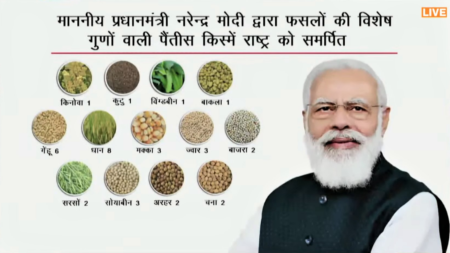- Genebanks on the BBC.
- A genebank for the Kahnawa’kehró:non.
- A genebank for Maharashtra.
- A (grapevine) genebank genotyped.
- A (potato) genebank used.
- A new tool for (coconut) genebanks.
Nibbles: Ancient Levant, Guinness cherry, NBPGR, Maize in Africa
- More than milk and honey.
- A very large cherry.
- A very large genebank.
- Let them eat sorghum, Zambian president says.
- That’s not an option for the Hopi.
Indian PM launches crop varieties
Brainfood: Domestication, Maize roots, Dental calculus, Psychedelic drugs, Green manures, Forage millet, VIR radish, Wild beans, Siberian dogs, Maize taxi, Dairying history
- Reconsidering domestication from a process archaeology perspective. De-colonising, and de-transitivising, domestication.
- Maize biochemistry in response to root herbivory was mediated by domestication, spread, and breeding. Not archaeology, but an example of the more expansive view of domestication being touted above.
- Tracking the transition to agriculture in Southern Europe through ancient DNA analysis of dental calculus. Agriculture was associated with some changes in oral microbiomes, but not nearly as big as happened relatively recently. One could perhaps argue that some oral commensals were domesticated? No? Too much? More on dental calculus below…
- The Failed Globalization of Psychedelic Drugs in the Early Modern World. Culture and religion affected why tobacco spread around and peyote didn’t. Wait, domestication had nothing to do with it?
- Estimating agronomically relevant symbiotic nitrogen fixation in green manure breeding programs. All the better to domesticate them.
- Assessing Forage Potential of the Global Collection of Finger Millet (Eleusine coracana (L.) Gaertn.) Conserved at the ICRISAT Genebank. The top 10 identified, and they’re not bad, considering forage potential was not what the crop was domesticated for. ILRI unavailable for comment :)
- Genetic Diversity of Phenotypic and Biochemical Traits in VIR Radish (Raphanus sativus L.) Germplasm Collection. More variable than was once thought. Ah, domestication, you never disappoint…
- Preliminary evaluation of wild bean (Phaseolus spp.) germplasm for resistance to Fusarium cuneirostrum and Fusarium oxysporum. Wait, domestication can disappoint after all. Deeply. At least we still have the CWR.
- Not so local: the population genetics of convergent adaptation in maize and teosinte. People moved maize about, post-domestication, usefully bringing it into contact with teosinte. But the main author Dr Silas Tittes says it better. Hail the maize taxi!
- Modern Siberian dog ancestry was shaped by several thousand years of Eurasian-wide trade and human dispersal. People moved dogs about, post-domestication. The doggie taxi?
- Dairying enabled Early Bronze Age Yamnaya steppe expansions. People moved around because of milk. But the main author Dr Shevan Wilkin says it better, and links this with other important papers. Dental calculus never disappoints.
Nibbles: Pasta al forno, Polynesian dispersal, Ryan Phelan talk
- More evidence that some food staples are going to be in trouble.
- Samoa to Rapa Nui in 400 years. But the Americas before that? Mash up with banana, taro and sweet potato next.
- TED talk on genetic rescue.
